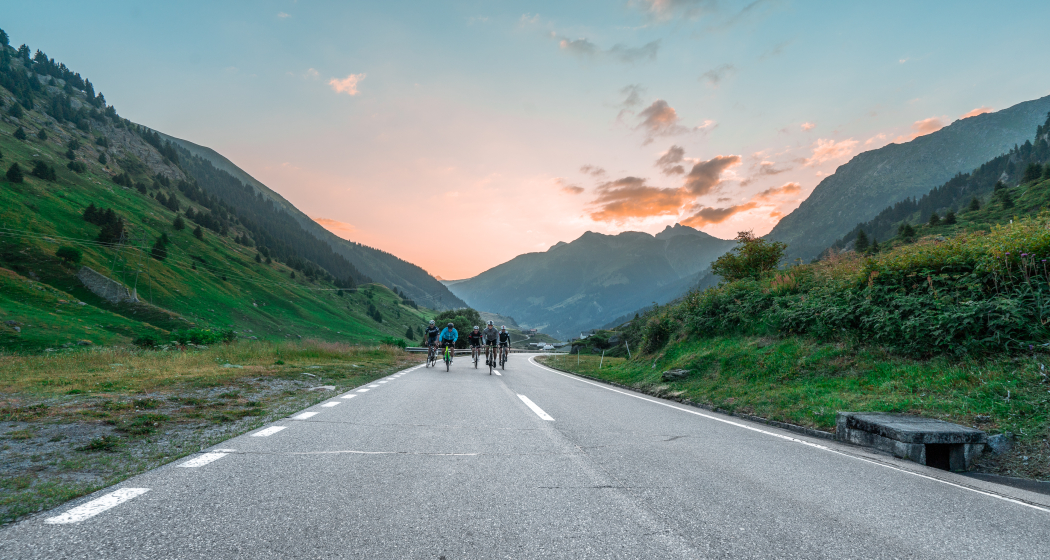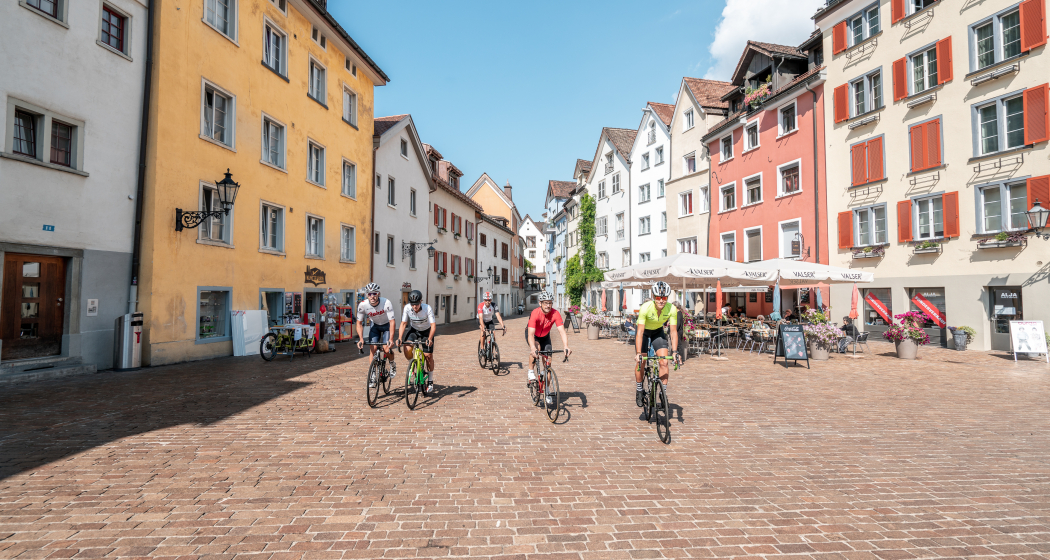Road cycling Route Source Region Rhine


Show all 8 images

Details
Description
Your journey starts in Chur, passing side streets you’ll discover the rolling hills of the Domleschg fruit and castle country. The route leads through the Viamala-Schlucht (gorge) natural monument and from here, the route climbs steadily through the valley of the Posterior Rhine. At the Roffla-Schlucht (gorge), the valley narrows, before finally reaching Splügen, the oldest pass village in Graubünden. Shortly after, the San Bernardino Pass, an Alp transit history classic attracts your attention. The pass’ numerous hairpin turns accelerate every racing bike enthusiast’s heart. Once at the top, a little rest is more than deserved. Soon after, the fast descent to the south is waiting for you to get down into the Misox. During the 44-kilometer descent, the landscape will surprise and astound you - high Alpine one minute, Mediterranean the next. Shortly after Roveredo, you’ll cross the Cantonal border from Graubünden to Ticino. Until Biasca, the terrain continues to rise gently. The Lukmanier Pass is a real treat which deserves to be at the top of the racing bike Olympus. The ascent leads through the Valle di Blenio to Olivone, where you’ll turn off into the Valle Santa Maria. At the Ospizio del Lucomagno you’ll not only find the passport sign, but it’ll also take you back to the canton of Graubünden. The descent will take you through Val Medel to Disentis. The journey continues along the Anterior Rhine through the Bündner Oberland, the Surselva. A detour over the Obersaxen plateau, which stuns with its countless hidden streets, will take you to Ilanz, the first city on the Rhine. From here, a spectacular road leads through the Ruinaulta: the Rheinschlucht (Rhine gorge), with its 300-meter high rock walls and rock formations also called "Little Swiss Canyon". Following the road will bring you back to Chur.
Stages
Geheimtipp
Tip: Don’t worry about carrying your luggage on this trip multi-day trip. Book the luggage transfer from hotel to hotel - convenient and easy.
Directions
Your journey starts in Chur (593m above sea level) and following the Rhine along the bike path, you’ll get to Reichenau. This is where the Posterior and Anterior Rhine come together, the two rivers that that we’re most interested in on this tour. On side roads, you’ll follow the road through the rolling hills of the Domleschg fruit and castle country. At Rothenbrunnen you’ll see the imposing Porta Raetica fortification whilst still on your bike. In Paspels, you’ll be able to admire the works of art by the well-known artist Robert Indermaur and the Schauenstein castle in Fürstenau will tempt you to take a first break. After passing through the historic trading town of Thusis (680m above sea level), the road ascends steadily. The Viamala-Schlucht (gorge) natural monument will have you in awe and you’ll soon forget all about the tough journey. The road runs spectacularly through the Viamala and a look into the gorge is certainly worthwhile. The route continues through the valley of the Posterior Rhine, passing the villages of Schamserberg until the valley narrows towards the Rofflaschlucht (gorge). The Roffla promises great insights into a wild ravine. The path ascends steadily but not steeply. Through the valley floor of the Rheinwald, you’ll reach Splügen (1,475m above sea level), the oldest pass village of
Graubünden.
Splügen - Biasca: 94.1 kilometers - 894 altitude
The Walser settlement Posterior Rhine (1,624m above sea level) at the foot of the Rheinwaldhorn is the starting point of the San Bernardino Pass, an Alp transit history classic. The pass’ numerous hairpin turns at 2066 altitude will accelerate every racing bike enthusiast’s heart. The ascent is steady, but doesn’t have any extremely steep ramps, so you can still enjoy the scenery. Once you arrive at the pass, taking a short break is well deserved. The Ospizio and the small lake invite you to relax. Soon, however, the anticipation of the rapid descent south to the Misox will have you jumping back into the saddle.
Let yourself be staggered by the diverse scenery during the 44-kilometer descent. The numerous hairpin turns will put a smile on your face. Surrounded by chestnut trees and grapevines, chill grotti along the roadside will startle you with their southern flair. Shortly after Roveredo, you’ll cross the canton border into Ticino and the last 20 kilometers will lead you to Biasca (301m above sea level) without having to put too much effort. The perfect starting point to tackle the Lukmanier Pass on the following day.
Biasca - Disentis: 60 kilometers - 1787 altitude
The beginning of the crowning stage takes off leisurely. Although the route ascends steadily from Biasca (301m above sea level), it’s enjoyable despite tired legs. The Lukmanier Pass is a real treat that deserves to be at the top of the racing bike Olympus. A 42-kilometer-long ascent with 1680 altitude can be hard on tired legs. The ascent continues through the Valle di Blenio to Olivone (902m above sea level) where you’ll turn into Valle Santa Maria. The ascent is constant but has quite a few crisp ramps. The actual pass is next to the Lai da Santa Maria mountain lake at 1972 altitude, the passport sign is located at the Ospizio del Lucomagno at 1914 altitude, where you’ll also get back to Graubünden. The descent leads through the Val Medel to Disentis (1,130m above sea level). A last short, crisp climb will bring you back into the village. From a distance, you’ll be able to see the imposing Benedictine monastery, which has had an impact on the town since the 13th century.
Disentis - Ilanz: 61.4 kilometers - 1570 altitude
From Disentis (1,130m above sea level) the journey continues along the Anterior Rhine through the Surselva, the largest Romansh-speaking area of Graubünden. In Trun (852m above sea level) you’ll turn off the main road and explore picturesque villages on the northern side of the valley at six kilometers and 300 meters above sea level. After swapping valley sides, you’ll be on the ascent in the direction of the Obersaxen plateau. The area was settled by the Walsers and acts a Swiss German language island in the middle of the Surselva. With its countless hidden streets, Obersaxen enthuses the most adventurous racing cyclists. Until you reach Meierhof (1,259m above sea level) you stay on the main road and then turn right in the center of the village. You’ll climb up a little higher and with turn of the paedals and the view into the Surselva gets more and more impressive. You’ll pass the villages of Miraniga, Misanenga and Surcuolm before tackling the last ascent of the day. At 1535 altitude, a magical view over the Val Lumnezia and the Rheinschlucht (Rhine gorge) will thrill you. Enjoy the winding descent in direction of Luven (998m above sea level), before you end the racing bike day in Ilanz (699m above sea level), the first city on the Rhine.
Ilanz - Chur: 47.5 kilometers - 1143 altitude
Shortly after Ilanz (699m above sea level), you’ll turn onto a small road to Sevgein and finally reach Riein (1,270m above sea level). The low-traffic and perfectly paved road ascends steeply at the beginning and soon you’ll leave the village of Sevgein behind you. From here, the street lights up its true magic. The road steadily ascends and the view of Valsertal is unique. Since Riein is a dead end for motorised vehicles, only a few cars can be found here.
After Riein, you’ll pass the ban on motorised vehicles and a narrow asphalt road leads you to Cuolm (1,550m above sea level) and Ober Dutjen. The idyllic landscape makes you forget all the hardships and the fast descent to Valendas (810m above sea level) with excellent views of the Rhine Valley is a pure reward. From Versam, a spectacular road leads through the Ruinaulta. The Rheinschucht (Rhine gorge), with its 300-meter high rock walls and rock formations also called "Little Swiss Canyon" ascends to Versam, before you are treated to a fast descent with fantastic hairpin bends. Over the bridge at the end of the descent, you’ll reach a short incline. You can anticipate rocky tunnels and a fantastic panoramic road. Take a little rest to enjoy the view of the gorge. The route will lead you to Bonaduz (662m above sea level) and Reichenau, where the Anterior and Posterior Rhine flow together and further back to Chur (593m above sea level).
Responsible for this content Graubünden Ferien.
This content has been translated automatically.
